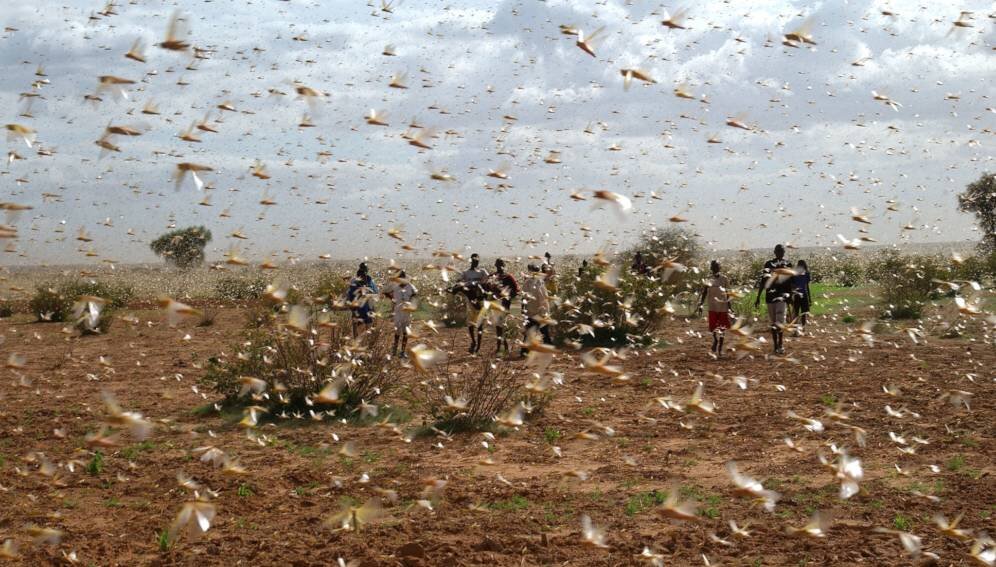
[ad_1]

Credit: FAO / Giampiero Diana
Millions face famine and food insecurity caused by a second desert locust outbreak as management resources are directed towards the COVID-19 crisis, scientists warn.
Pesticide shipments to the worst-affected areas in East Africa have been delayed due to air travel restrictions put in place to contain the COVID-19 pandemic.
About 20 million people are already experiencing acute food insecurity in Ethiopia, Kenya, Somalia, South Sudan, Uganda and Tanzania, according to the Food and Agriculture Organization (FAO).
Widespread rains that fell in East Africa in March and April could lead to an explosion in desert locust numbers, the FAO warned in a report published last week (4 May).
“Another generation of breeding will cause locust numbers to increase further as new hopper bands and swarms form in Ethiopia, Kenya and Somalia during May and June,” the report says.
“Swarms are expected to move further north in Ethiopia and Somalia with the risk that a few swarms may reach Eritrea and Sudan in mid-June.”
Kim Kariuki, engagement director at the Busara Center for Behavioral Economics, Kenya, says the second wave of desert locust invasion could exacerbate the disruption of global supply chains resulting from the COVID-19 pandemic.
“This would have untold effects on food security… leaving smallholders even more vulnerable than before and jeopardizing the economic outlook for recovery in the affected countries,” he explains.
Keith Cressman, the FAO’S senior locust forecaster, tells SciDev.Net that the situation in East Africa can be described as an upsurge and not a plague.
“But it could become a plague if control operations are not adequate and weather favorable to breeding and further spread to other countries occurs,” he says.
Daniel Otaye, an associate professor and chairman in the Department of Biological Sciences, Egerton University in Kenya, says East African countries seem unprepared to deal with a second wave of locust invasion.
“Policymakers in Sub-Saharan Africa should be strongly advised not to forget the locust outbreak amid COVID-19 outbreak. The two challenges should be fought concurrently,” Otaye says.
The report says Saudi Arabia, Oman and Yemen are under increasing threat of locust invasions.
Otaye adds that most governments in the region have diverted available resources to control COVID-19, to the neglect of fighting locust invasion.
“The biggest challenge we are facing at the moment is the supply of pesticides and we have delays because global air freight has been reduced significantly,” added Cyril Ferrand, the FAO’s resilience team leader for East Africa.
Cressman says there have been continued efforts to control the outbreak, including mass trainings and treatment of thousands of hectares in affected regions.
“So far more than 240,000 hectares have been treated with chemical pesticides or biopesticides across the East Africa region and 740 people have been trained up to conduct ground locust control operations,” he says.
Stephen Njoka, the director-general of the Desert Locust Control Organization for East Africa (DLCO-EA), tells SciDev.Net that East Africa was already grappling with locust invasions prior to COVID-19.
He adds that there have been combined efforts by the DLCO-EA, national governments and the FAO to focus on controlling the locusts by aerial and ground control using pesticides.
“However, the new generation hoppers are now of age and very voracious. Their numbers are much more than their parents,” Njoka tells SciDev.Net
According to Njoka, there should be continued surveillance and control by hitting the locusts at their weakest phases — as hoppers and at the immature stages before egg laying. “One DLCO-EA aircraft is currently conducting cross-border control from Lodwar (Kenya) to Moroto (Uganda) and is soon to be deployed to South Sudan,” he adds.
Cressman says digital apps enable countries to share data.
“FAO is encouraging all countries to use eLocust3, a rugged handheld tablet and app, which records and transmits data in real time via satellite to national locust centers and to the Desert Locust Information Service (DLIS) based at FAO headquarters in Rome,” he says.
Supercomputer helps in tracking East Africa locust outbreak
FAO Desert Locust Bulletin: www.fao.org/ag/locusts/common/… g / 2551 / en / DL499e.pdf
Provided by
SciDev.Net
Citation:
New locust outbreak threatens food security for millions (2020, May 13)
retrieved May 13, 2020
from https://phys.org/news/2020-05-locust-outbreak-threatens-food-millions.html
This document is subject to copyright. Apart from any fair dealing for the purpose of private study or research, no
part may be reproduced without the written permission. The content is provided for information purposes only.
[ad_2]